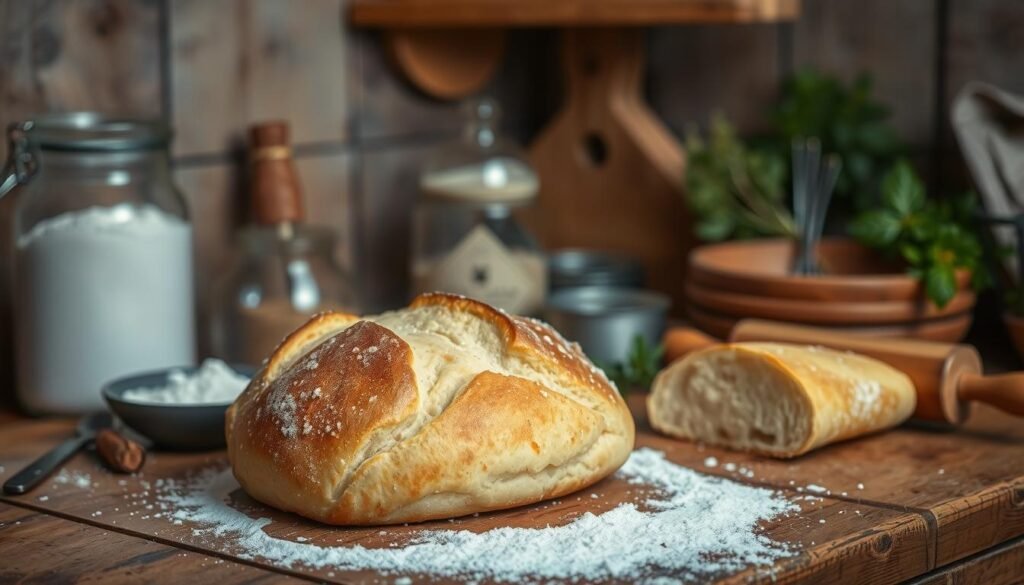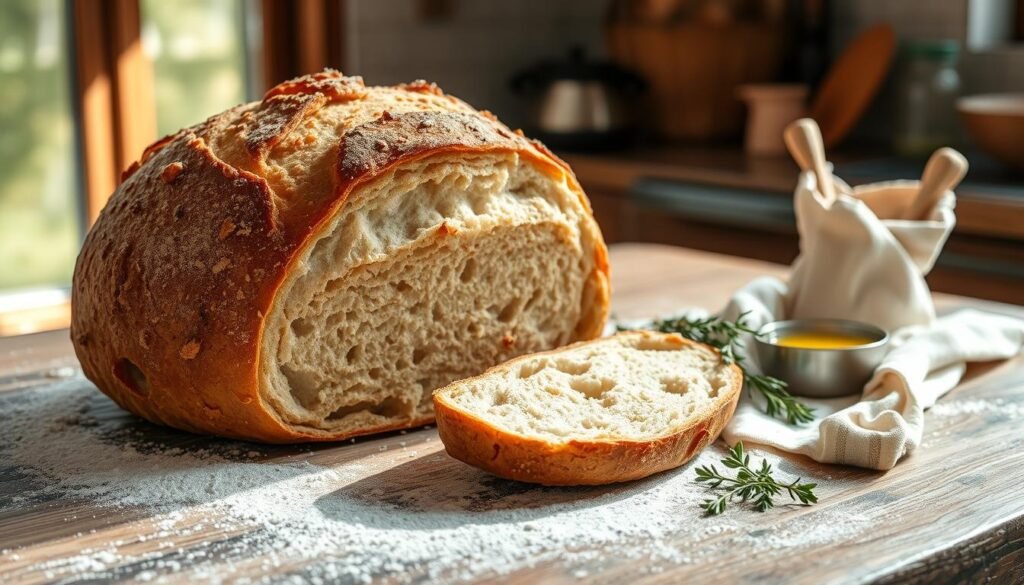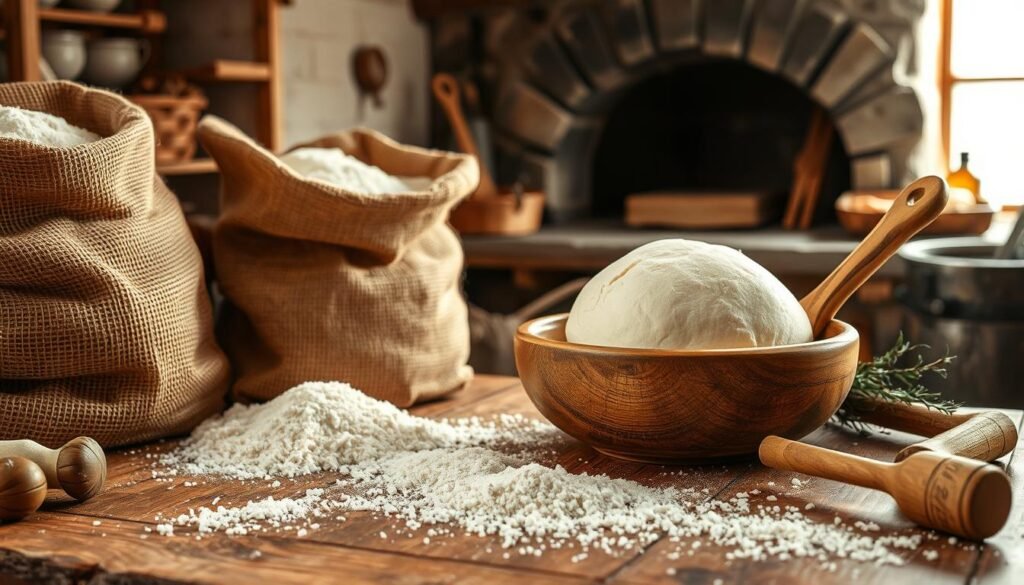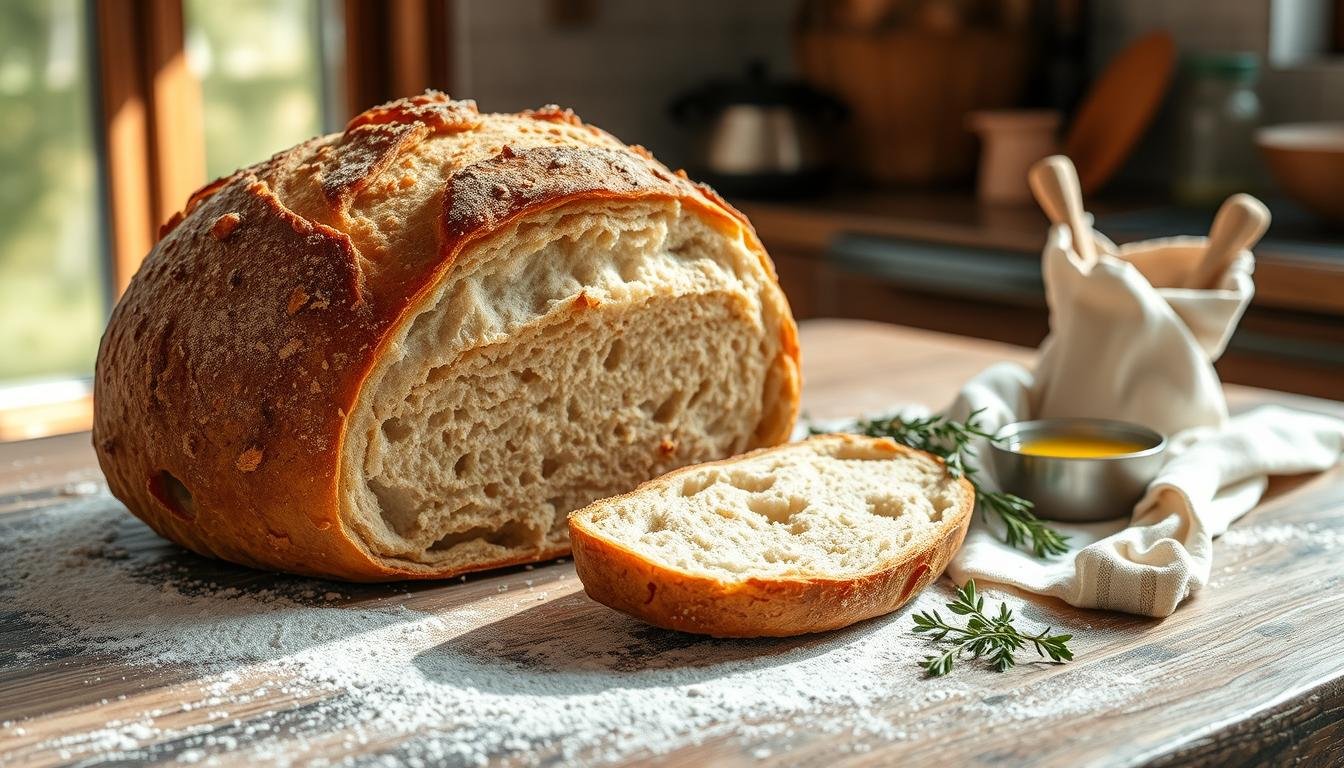The Reka bread recipe brings something special to your home—the smell of freshly baked bread. It’s more than just a tasty treat; it’s a sign of love, warmth, and tradition. Think about the moments you’ve shared with loved ones over a warm loaf of bread. It brings people together, doesn’t it?
The Reka bread recipe captures this spirit of togetherness. It welcomes both experienced bakers and newcomers to enjoy the joy of homemade bread. Making Reka bread is easy and rewarding. It offers a unique taste and texture that store-bought bread can’t match. Let’s explore how to make Reka bread and bring that warmth into your kitchen.

Key Takeaways
- The Reka bread recipe is accessible for all skill levels.
- Freshly baked bread creates memorable moments with loved ones.
- Homemade bread enhances unique flavors and textures.
- Making bread at home is both rewarding and simple.
- Easy preparation leads to delicious results.
Introduction to Traditional Reka Bread Recipe
Exploring the traditional Reka bread recipe opens a door to a world of culinary heritage. It’s more than just food; it’s a link to baking traditions passed down through generations. The aroma of this bread fills your kitchen, bringing back memories of the past.
Making Reka bread is simple yet warm, a favorite in many homes. Families come together, sharing stories and laughter as the bread rises. It’s not just a meal; it’s a way to create lasting memories and feel connected.
As you learn more about this recipe, you’ll uncover special techniques and ingredients. Each loaf is a tribute to tradition, perfect on its own or with your favorite meals. Making homemade Reka bread will surely enhance your cooking adventures.
For more tips on perfecting traditional bread recipes, check out this helpful guide to mastering baking techniques.

Origins and History
The story of Reka bread recipe goes back centuries in European cooking. It has a rich history of bread that has changed over time. Each region in Europe has added its own twist to Reka bread, making it unique. Learn more about the fascinating history of bread and its cultural significance by visiting this comprehensive guide.
In many European countries, baking bread is a long-standing tradition. Recipes are often shared from one generation to the next, changing slightly. Reka bread shows how location shapes its taste and style.
Baking Reka bread at 375°F (190°C) is a common practice among European breads. This temperature is a standard, but each region can adjust it to their liking. Making Reka bread requires patience and attention to detail.
| Preparation Step | Time |
|---|---|
| Mixing Dough | 10 minutes |
| Kneading | 10-15 minutes |
| Proofing | 1 hour |
| Shaping | 10 minutes |
| Baking | 35-40 minutes |
Exploring the origins of Reka bread recipe can deepen your appreciation for it. It connects you to the traditions that have made it a favorite in Europe.

What Makes Reka Bread Recipe Special
The Reka bread recipe is special because it mixes old and new baking ways. This mix gives a bread with unique tastes and textures. It’s loved by many for its soft crust and fluffy inside.
Reka bread is made with top-notch ingredients. It uses the best flour, yeast, sugar, and salt. This makes it taste amazing, whether eaten fresh or as part of a meal.
Also, Reka bread is great for getting creative in the kitchen. You can add herbs, spices, or cheeses to change its taste. This lets you make every loaf your own.
| Characteristic | Description |
|---|---|
| Texture | Soft and fluffy with a tender crust |
| Ingredients | High-quality flour, yeast, sugar, salt |
| Versatility | Perfect for sandwiches, toasts, or with soups |
| Customization | Can incorporate various herbs and spices for unique flavors |
By knowing and using the special features of Reka bread, you can make a truly special loaf. It will make your family and friends happy.
Essential Ingredients for Your Reka Bread Recipe
Making delicious Reka bread starts with the right ingredients. The perfect mix ensures great taste and texture. Here’s what you need for your Reka bread, along with tips for picking the best ingredients.
The key to making delicious Reka bread lies in understanding the art of breadmaking, which involves techniques passed down through generations. You can delve deeper into these methods here.
List of Ingredients
- High-grade or bread flour: 4 cups
- Instant yeast: 1 sachet (8g) or 2 tbsp active yeast
- Salt: 2 tsp
- Sugar: 4 tbsp
- Warm water: 2 cups
Choosing Quality Ingredients
Choosing fresh, quality ingredients is key for your Reka bread recipe. The flour you pick greatly affects the bread’s texture and taste. Go for high-grade bread flour, as it has more protein. This helps your dough rise well.
Fresh yeast is essential for a light, airy loaf. For salt and sugar, choose natural products without additives. Using these ingredients will make your baking better and your homemade bread more enjoyable.
Required Kitchen Equipment and Tools
When you’re ready to make Reka bread recipe, the right tools can really help. Having the right baking equipment makes the process smoother and improves the bread’s taste and texture. Essential baking tools make baking easier and better.
Basic Kitchen Equipment
Start by gathering these basic kitchen tools:
- Large mixing bowl
- Measuring cups and spoons for precise ingredient quantities
- Baking sheet for placing your bread
- Stirring utensils such as spatulas or wooden spoons
- Loaf pan, preferably 8×4 inches or 9×5 inches
- Oven thermometer to ensure accurate baking temperatures
- Cooling rack for resting the baked bread
- Parchment paper to line the baking pan, making cleanup easier
Optional Baking Tools
For better results, consider these optional tools:
- Stand mixer for effortless dough mixing and kneading
- Baking stone for achieving a superior crust
- Instant Pot or electric pressure cooker for a convenient proofing environment
- Silicone baking mats for additional non-stick properties
- Bench scraper to assist in dough handling and shaping
Preparing Your Workspace and Ingredients
Setting up a good workspace for baking is key to making great Reka bread recipe. Clear your countertop to keep things organized. Have all your tools and ingredients ready to avoid any hiccups.
Measuring ingredients accurately is vital. Use the right amounts, like 500g of Sharpham Park Baker’s Blend, for the best flavor and texture. Make sure to measure liquids carefully too, like 300ml of a mix of water and dark ale. Fresh ingredients are also important for the taste of your Reka bread.
Once you’ve set up, you can focus on the fun parts of making Reka bread recipe. Spend 5 to 10 minutes kneading the dough to improve its texture. Let it rise for about an hour, so it grows by 50%. A well-prepared space makes these steps easy and fun!
| Ingredient | Measurement |
|---|---|
| Wholegrain Spelt Flour | 300g |
| White Spelt Flour | 200g |
| Hand-Hot Water | 200ml |
| Dark Ale | 100ml |
| Fine Salt | 1 tsp |
| Instant Yeast | 1 tsp |
| Total of all Ingredients | 1 loaf (450-500g) |
Step-by-Step Reka Bread Recipe
Starting your Reka bread recipe journey is exciting. You’ll follow simple steps to make a delicious loaf. You’ll learn how to mix, knead, let it rise, and bake it to perfection.
Making the Dough
First, get your ingredients ready. You’ll need 400 grams of flour, 62.5 grams of sugar, 15 grams of yeast, and more. Mix these in a big bowl to form a dough.
Kneading Techniques
After mixing, knead the dough on a floured surface. Do this for 10 minutes until it’s smooth. This step makes the bread chewy and strong.
Proofing Process
Now, let the dough rise. Put it in a greased bowl, cover it, and wait 30-40 minutes. It will double in size. Then, punch it down, shape it, and let it rise again for 30 minutes.
Baking Instructions
Heat your oven to 200 °C (392 °F). Shape the dough, put it in a dish, and let it rise. Bake for 35 minutes until it’s hollow. Let it cool for 15 minutes before slicing. Enjoy your warm Reka bread!
Understanding the Perfect Texture and Consistency
Getting the right texture and consistency in Reka bread recipe is key. Many factors, like softness and crispiness, play a part. Each step, from picking ingredients to baking, shapes the bread’s final look.
Factors Affecting Texture
Several things affect the bread’s texture. Important ones include:
- Flour Type: Choosing whole wheat or all-purpose flour changes the texture.
- Yeast Activity: Fresh yeast makes the bread light, while old yeast makes it denser.
- Water Temperature: Warm water helps yeast work well, important for a good rise.
- Kneading Time: Kneading builds gluten, making the bread chewy and structured.
- Proofing Duration: Longer rising times create fluffier bread with better air pockets.
Achieving Desired Consistency
To get the perfect consistency in your Reka bread, follow these tips:
- Use the right amount of flour to avoid a dry loaf.
- Add honey for moisture and taste.
- Stick to the recommended resting and kneading times.
- Check if the loaf sounds hollow when tapped to see if it’s done.
- Let the bread cool well after baking for better slices.
By watching these texture factors and adjusting as you go, you’ll get a Reka bread that’s just right. It will be a hit every time you bake it.
Common Mistakes to Avoid
Baking Reka bread recipe can be rewarding but also challenging. Many bakers face common errors that can ruin their bread. Knowing how to fix these issues helps you improve your baking skills and enjoy a tasty loaf every time.
Dough Problems and Solutions
Working with dough can bring up several issues. Here are some common Reka bread mistakes and how to solve them:
- Overmixing the Dough: This can make your bread tough. Mix for about 15 minutes to blend ingredients well without overdoing it.
- Underproofing: If the dough doesn’t proof enough, your bread will be dense. Make sure to let it proof for at least 1 hour at room temperature, then slow proof overnight to improve its texture.
- Incorrect Flour and Water Ratio: The right hydration is key. Use 400 g of flour with 325 g of water for the best results.
Baking Issues Fixed
During baking Reka bread recipe, you might face some challenges. Here are some troubleshooting bread issues and their fixes:
- Uneven Crust: Keep your oven temperature even and use a baking stone for better heat distribution.
- Underbaked Center: Check the internal temperature; Reka bread should be between 190-200º F (88-93º C). Adjust the baking time as needed.
- Excessive Crumb: A dense crumb may mean poor gluten development. Practice proper folding and give the dough enough resting time.
| Common Mistake | Impact | Solution |
|---|---|---|
| Overmixing | Tough texture | Mix for 15 minutes, stop when homogenous |
| Underproofing | Denser bread | Proof for at least 1 hour, preferably overnight |
| Incorrect Hydration | Dry bread | Maintain 400 g flour with 325 g water |
| Uneven Baking | Inconsistent texture and appearance | Check oven temperature regularly |
| Underbaked Center | Raw taste | Monitor internal temperature |
| Excessive Crumb | Heavy texture | Focus on proper folding and resting |
Storage and Freshness Tips
Storing homemade bread right is key to keeping it fresh. After baking your Reka bread recipe, try these easy tips:
- Room Temperature Storage: For fresh bread, keep it at room temperature. A bread box or paper bag is best. It keeps the crust crunchy and the inside moist.
- Avoid Plastic: Don’t use plastic bags at room temperature. They trap moisture and can cause mold.
- Freezing Bread: To keep bread longer, freeze it. Slice the Reka bread first. Then, wrap it in aluminum foil or freezer paper. Put it in a resealable bag. This way, it’s easy to thaw and keeps the texture good.
- Thawing Techniques: To thaw frozen bread, let slices sit at room temperature or use the microwave. But don’t toast frozen slices directly. It can make them unevenly heated.
By using these Reka bread storage tips, your homemade bread stays tasty and fresh for days. The secret to keeping bread fresh is in how you store it.
Conclusion
As you finish exploring the Reka bread recipe, making homemade bread is rewarding and easy. You start with 2 cups of whole wheat flour and 1 cup of bread flour. Then, you knead and bake, enjoying wonderful smells and tastes.
The Reka bread summary is more than just a recipe. It’s about the joy of baking. It adds a new skill to your kitchen.
Homemade Reka bread recipe has many benefits. You know what’s in your food and enjoy its rich flavors. By using the tips from this article, you can make delicious bread for any meal.
So, why not try making it? Each loaf shows your effort and love for baking. Baking is an art that lets you be creative and share with loved ones.
Explore more delightful recipes on Daily Recipe Hub, such as Traditional Moroccan Chicken Couscous, Gourmet Pizza Quattro Formaggi, and Easy Leche de Tigre, offering a variety of flavors and culinary adventures.
FAQ
What is a Reka bread recipe?
A Reka bread recipe is a special way to make bread at home. It uses top-notch ingredients and simple steps to create tasty homemade loaves.
How do I ensure my Reka bread has the right texture?
For the right texture, focus on the flour, yeast, and how you knead, proof, and bake the bread.
What ingredients do I need for Reka bread?
You’ll need good bread flour, yeast, salt, sugar, and warm water. Fresh, quality ingredients make your bread taste and feel better.
What kitchen tools are necessary for baking Reka bread?
You’ll need a big mixing bowl, measuring cups, and a baking sheet. Tools like a stand mixer or baking stone can make baking easier.
How should I store my homemade Reka bread?
Store your bread at room temperature in a bread box or plastic bag. Freezing it keeps it fresh for longer.
Can I customize the Reka bread recipe?
Yes! You can add herbs, spices, seeds, or nuts to make it your own.
What are some common mistakes to avoid when baking Reka bread?
Avoid overmixing, underproofing, and wrong ingredient measurements. Knowing these mistakes helps you bake better.
Is Reka bread gluten-free?
Traditional Reka bread uses wheat flour, so it’s not gluten-free. But, you can try gluten-free flour blends for a gluten-free version.
